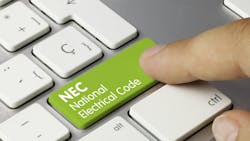Understanding General Requirements of the NEC, Part 10
Takeaways
- Section 110.15 requires marking the high leg of a delta-connected 4-wire system where the midpoint of one phase is grounded.
- Arc flash warnings are required on equipment likely to need maintenance while energized, especially for service and feeder equipment rated 1000A or more.
- Proper signage and markings are critical for safety, and using manufacturer-provided labels can reduce costs and improve clarity.
Article 110 provides general requirements for all installations.
Section 110.15 requires marking the high leg of a delta-connected 4-wire system where the midpoint of one phase is grounded. Such a marking must be placed at each point where a connection is made if the grounded conductor is also present.
An arc flash warning is required if certain types of equipment are likely to require examination, adjustment, servicing, or maintenance while energized [Sec. 110.16(A)]. The equipment that the NEC is addressing is anything that could pose an arc flash hazard. This includes switchboards, switchgear, and motor control panels. And dwelling units are explicitly excluded from this requirement, which means it applies to commercial and industrial installations.
Service equipment and feeder-supplied equipment rated 1000A or more must have an arc flash warning regardless of whether it has the conditions listed in Sec. 110.16(A) (e.g., likely to require examination, et al, while energized) [Sec. 110.16(B)]. In either case, the label must be legible, durable, permanently affixed, and clearly visible to qualified persons. Other marking requirements that apply generally are provided by Sec. 110.21.
The NEC has long used seemingly unnecessary verbiage in its requirements for signs and markings, for example the words legible and durable. Who would bother putting up a sign that people can’t read or adding markings that can’t quite be made out? Or who tape notebook paper on an enclosure instead of rivet or screw a hard plaque on there? Well, there have long been seemingly unnecessary violations of common sense for signs and markings. Thus the verbiage.
Which brings us to another important point about signs and markings. This requirement exists for the safety of everyone who is going to perform examination, adjustment, servicing, or maintenance of that equipment for the next 30 or 40 years or however long it’s in service. As you install that equipment and consider the label and marking requirements, also consider how many lives will be affected by the quality of your work with the labels and markings. For example, don’t just put the label in a spot where it’s visible but put it in a spot where it’s prominent.
Toward this end, if the manufacturer provides the option of factory signs or markings and you’re the one ordering the gear, take the option. This will cost less and be better than doing this work in the field.
If you’re involved with maintenance rather than installation, look for ways to add icons or images of these labels to your procedures. Many procedures today are on tablets rather than paper, giving you some “Notice this” options not possible with paper. The training that ensures a qualified person is doing the work should cover what labels and markings are on specific equipment, why those are present, and what protection measures are indicated. The training should also stress that while an arc flash label means there’s an arc flash hazard, the absence of an arc flash label does not mean there’s no arc flash hazard.
About the Author

Mark Lamendola
Mark is an expert in maintenance management, having racked up an impressive track record during his time working in the field. He also has extensive knowledge of, and practical expertise with, the National Electrical Code (NEC). Through his consulting business, he provides articles and training materials on electrical topics, specializing in making difficult subjects easy to understand and focusing on the practical aspects of electrical work.
Prior to starting his own business, Mark served as the Technical Editor on EC&M for six years, worked three years in nuclear maintenance, six years as a contract project engineer/project manager, three years as a systems engineer, and three years in plant maintenance management.
Mark earned an AAS degree from Rock Valley College, a BSEET from Columbia Pacific University, and an MBA from Lake Erie College. He’s also completed several related certifications over the years and even was formerly licensed as a Master Electrician. He is a Senior Member of the IEEE and past Chairman of the Kansas City Chapters of both the IEEE and the IEEE Computer Society. Mark also served as the program director for, a board member of, and webmaster of, the Midwest Chapter of the 7x24 Exchange. He has also held memberships with the following organizations: NETA, NFPA, International Association of Webmasters, and Institute of Certified Professional Managers.
